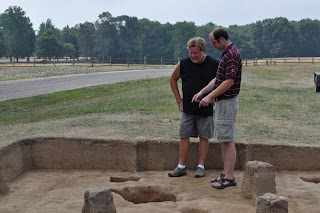 have been working hard to collect all the historical information they can on the Great House from the past 270 years. Armed with this information and years of experience, a team descended on the Great House last week for three days of intense physical investigation.
have been working hard to collect all the historical information they can on the Great House from the past 270 years. Armed with this information and years of experience, a team descended on the Great House last week for three days of intense physical investigation.Prior to their arrival, we opened multiple probe areas throughout the first floor so they could see what evidence might be behind the plaster. Other physical evidence they examined and scrutinized included nail holes, wear patterns on the floors, scars and patches in the wood work, and wall framing that could be observed from the attic. We are waiting for the team to analyze their finds before we share too much, but I can share one or two discoveries. One question we think we answered is that the unique niches in the East and West Passages appear to be original with a little reworking by "Light Horse Harry" Lee. One other discovery we were not expecting is that the evidence points to a closet being present in the back section of the Nursery that would have been accessible from the adjoining Chamber.
 d about this report being finished and sharing the information with everyone. This HSR will be a invaluable resource for the Preservation, Collections and Education Departments here at Stratford Hall. The HSR will be a guide for all of us as we continue to restore, refurnish, and interpret the Great House for our visitors. And we would all like to thank everyone for their patience as we work to make the Great House an overall better educational experience.
d about this report being finished and sharing the information with everyone. This HSR will be a invaluable resource for the Preservation, Collections and Education Departments here at Stratford Hall. The HSR will be a guide for all of us as we continue to restore, refurnish, and interpret the Great House for our visitors. And we would all like to thank everyone for their patience as we work to make the Great House an overall better educational experience.







